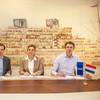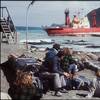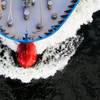By JOC David Nagle, Naval Sea Systems Command Public Affairs
The rescue of the nine coal miners in Somerset, Pa. last weekend involved the efforts of several local, state and federal agencies working together. This team included members of the Navy’s diving and salvage community, including divers from Naval Sea Systems Command’s Supervisor of Salvage and Diving (SUPSALV) directorate and Explosive Ordnance Disposal (EOD) Technical Division in Indian Head, Md.
When the Navy learned of the mine collapse, the Chief of Naval Operations’ Office directed SUPSALV to support the rescue operations by providing assistance and equipment to treat the miners for possible decompression problems. SUPSALV quickly assembled a team of diving and medical experts from the Fleet – from commands including Underwater Construction Team One, Mobile Diving and Salvage Unit Two, EOD Mobile Unit Two, SEAL Delivery Vehicle Team Two, EOD Technical Division (EODTECHDIV) and the Bureau of Medicine. Within hours, the SUPSALV and EODTECHDIV personnel were on scene, with the rest of the team on their way to Somerset to assist.SUPSALV learned that the miners were trapped in an area of the mine containing an air pocket. As the water level increased in the mine, it caused the pressure in the air pocket to increase, creating an environment of pressure equivalent to being in 40 feet of water.“Assuming the miners remained in that pressure environment, they would have needed about 25 hours to decompress in the mine, or about five hours if they were transferred to a recompression chamber and given oxygen to speed decompression,” said Medical Corps Capt. Henry Schwartz, SUPSALV’s Diving Medical Officer and the senior Navy representative at the rescue site.The Navy diving team arrived with decompression chambers and the new Emergency Evacuation Hyperbaric Stretchers (EEHS), foldable Kevlar tubes just now being delivered to the Fleet. The SUPSALV personnel brought one of the EEHS units with them, carrying it in the back of a rented vehicle.Within 18 hours of receiving the first phone call, the diving team was set up and ready to treat miners.Meanwhile, the rescue team pumped water from the mine, lowering the pressure in the area where the miners were trapped. This action slowly decompressed the space and the miners, to the point where the pressure was normal by the time the miners were rescued. Schwartz and a hospital corpsman from EODTECHDIV treated one of the miners with symptoms of decompression illness, using a Transportable Recompression Chamber System, with good results.Throughout the rescue operation, there was a general feeling of optimism by both the rescuers and the family members of the trapped miners.“It was extremely gratifying to see all the various people and groups pulling together,” recalled Schwartz. “Little has been said about the drillers, but they worked around the clock with little rest for three days.”This operation provided the added benefit of training for the diving community, said Schwartz.“It gave us the chance to rapidly mobilize units for a scenario that could be very similar to a disabled submarine with men trapped under increased pressure at the bottom,” he said. The overall operation and the Navy’s participation ran “textbook smooth,” according to Schwartz, due in large part to the professionalism and dedication of the Navy diving community.“Our preparation went rapidly because many of our people accepted responsibility before being officially tasked,” he said. “When the tasking came down, they were ready to go.“I was proud to represent the Navy, and I’m sure to a person everyone else in our group was as well.”
Source: NAVSEA
Subscribe for
Maritime Reporter E-News
Maritime Reporter E-News is the maritime industry's largest circulation and most authoritative ENews Service, delivered to your Email five times per week












